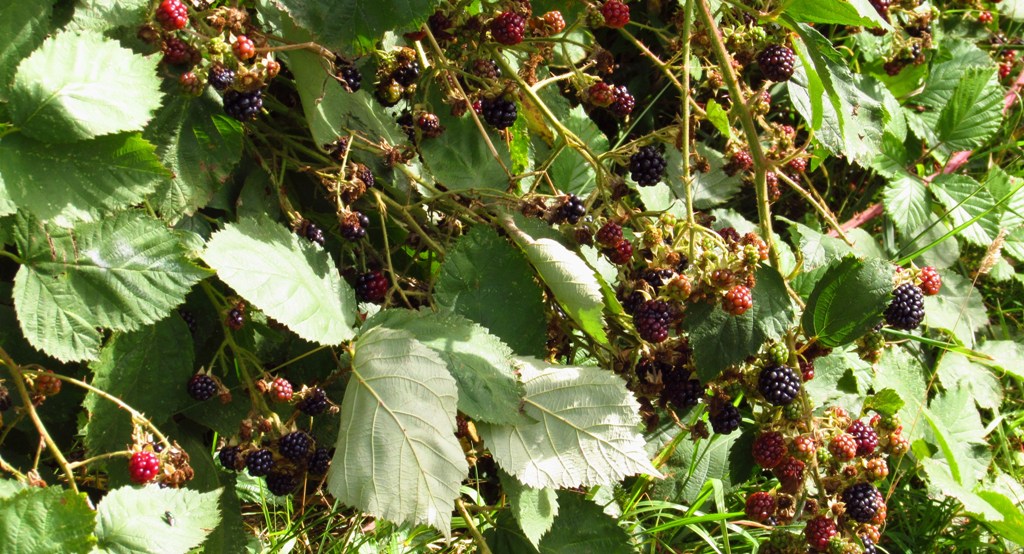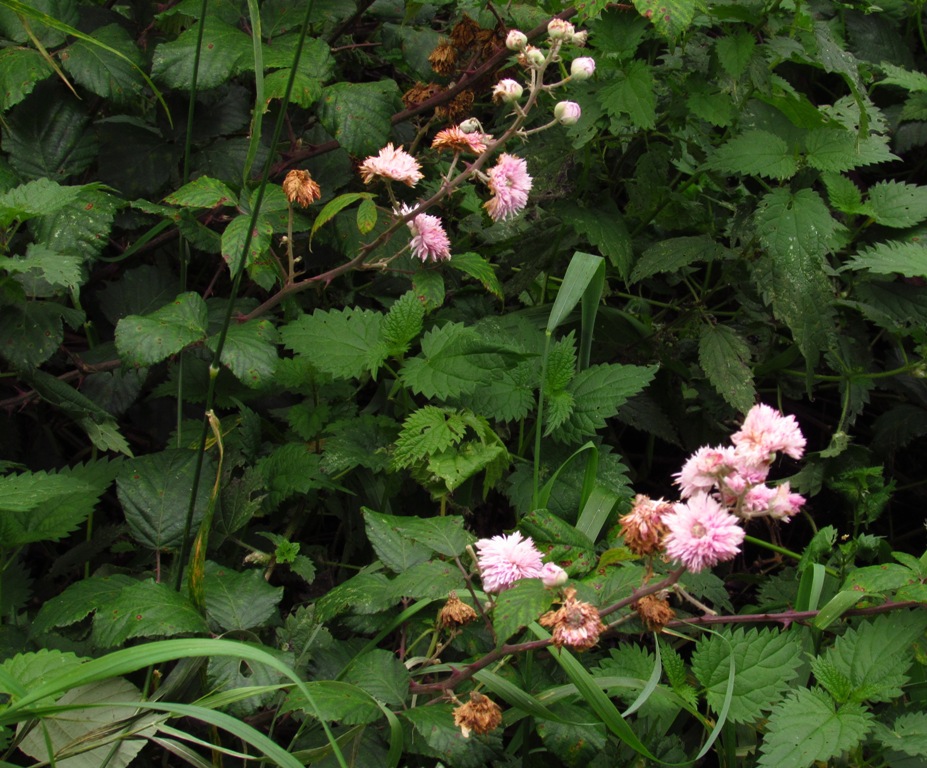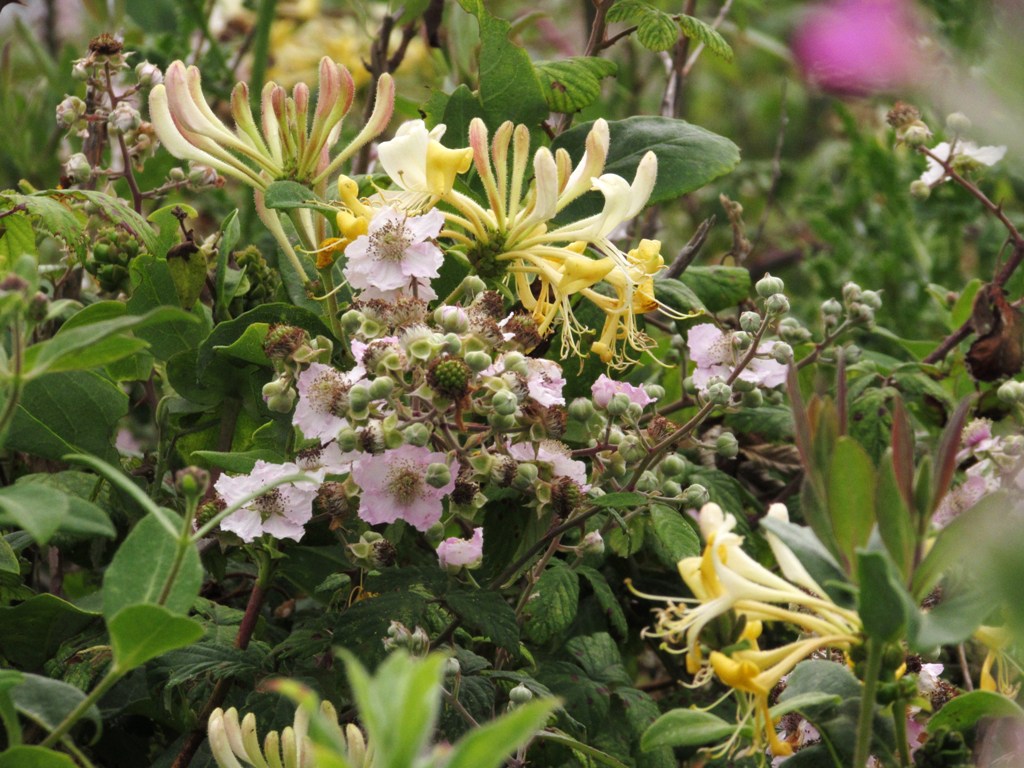Blackberry, Bramble or Rubus aggr.

The genus Rubus is part of the Rose family which is family number 48 in Stace. See for more about the woody Rosaceae in my post here.
The Brambles, which is one of the common names of Rubus has several native species but the one we know best is called the Blackberry (the useful, edible one) or Bramble (the nasty, spiny one).
I use colour coding for easy reading! Blue background is general interesting info (although I hope you find it all interesting!!). Green is about all the uses except for medicinal uses or if there is a warning in which case I use a pink background. Pictures by Matt Summers unless stated.
The Scientific name of the Blackberry or Bramble used to be Rubus fruticosus but it is now often just called Rubus aggr. as the species consist of well over 300 microspecies.
The reason for this is that the Blackberry is very diverse in its looks and habits but not diverse enough to be separated in hundreds of different species. If you observe all the Blackberries wherever you go you may find that you see different flower colours, sizes and habit of growth. We noticed a very ornamental early, white flowering one, in mid June at Sutton Park and another pink, double form in early October at Rosliston Forestry Centre a few years ago.

These are extremes perhaps but normally plant species are a lot more clear-cut. I found some easily explained information through the Plants for a Future website which is, as I have said in this blog before; a wealth of information!
“Rubus fruticosus is an aggregate species made up of several hundred slightly differing species. The reason for this is that most seed is produced by a non-sexual method (Apomixis) and is therefore genetically identical to the parent plant.
On occasions when sexual production of seed takes place, the offspring will all be slightly different from the parent plant and will then usually reproduce as a new species by means of apomixy. Modern treatment of this aggregate usually does not use the name R. fruticosus because of the confusion over which species it should apply to”.
But this is the more scientific, what Stace has to say about it on page 241:
“Most of the taxa of subgenus Rubus (taxa 12-25) form an extremely complex, largely apomictic group (sect. Glandulosus), often known collectively as R. fruticosus L. agg. Two other sections (Rubus and Corylifolii) are often included within this aggregate, but they are probably derived from ancient and some recent hybrids between it and R. idaeus or R. allegheniensis, and R. caesius, respectively, and are here treated separately. R. caesius forms a 4th section. Over 400 microspp. (334 currently) have been recognised in BI in these 4 sections together”.
The time of writing this blog coincides with the blackberry season which inspired me to write about this important, as well as tasty, plant! There is a lovely poem by Walt Whitman about blackberry in ‘Song of Myself’ (1855) mentioned in ‘Hedgerow Medicine’ (p. 16). It is a very long poem (over 1300 lines) if you care to read it all here: below just a few lines mentioning the blackberry:
“I believe a leaf of grass is no less than the journey work of the stars/ …. and the running blackberry would adorn the parlors of heaven”.
But another writer just refers to the blackberry as a ‘primitive thug’ (in J. Roberts’s history of fruit and vegetables (2001))!
For me the blackberry is mainly positive because of its lovely fruit that I gladly pick each year and eat with my breakfast cereal or as a preserve mixed with apple in my ‘famous’ (well at least among friends and family) Dutch appletart!
There are plenty of recipes on line and I am going to try and make Blackberry spread, often called blackberry butter, for the first time this year! See about a similar jam here:
General information about the blackberry:
The Blackberry plant is edible and medicinal.
Delicious Blackberries are edible raw or made into jelly or jam. Blackberry leaf is more commonly used as a medicinal herb, but the root also has medicinal value..
Each individual blackberry, when ripe, is made up of 20-50 single seeds known as drupelets that are small, juice-filled and a deep purplish black. Technically, they are an ‘aggregate fruit’ rather than a berry. (Another meaning for the aggr. we have been talking about before!)
Nutritional benefits of blackberries:
Blackberries contain a wide array of important nutrients including potassium, magnesium and calcium, as well as vitamins A, C, E and most of our B vitamins. They are also a rich source of anthocyanins, powerful antioxidants that give blackberries their deep purple colour.
Young edible shoots are harvested in the spring, peeled and used in salads. This is useful when you need to tidy up the plants anyway in early spring. The thorns should still feel soft. I’ve eaten them steamed as an asparagus substitute. Not tried them raw in salads yet.
Medicinal Uses:
- The root-bark and the leaves are strongly astringent, depurative, diuretic, tonic and vulnerary.
- They make an excellent remedy for dysentery, diarrhoea, haemorrhoids, cystitis etc, the root is the most astringent.
- Externally, they are used as a gargle to treat sore throats, mouth ulcers and gum inflammations.
- A decoction of the leaves is useful as a gargle in treating thrush and also makes a good general mouthwash.
Other Uses:
- A purple to dull blue dye is obtained from the fruit
- A fibre is obtained from the stem and used to make twine
- The flowers and fruits are very beneficial to a host of wildlife. Plants are spread by seed deposited in the droppings of birds and mammals. They often spring up in burnt-over, logged or abandoned land and it
- Makes an excellent pioneer species, creating the right conditions for woodland trees to move in. The trees will often grow in the middle of a clump of blackberries, the prickly stems protecting them from rabbits!
- Plants form dense thickets and this makes excellent cover for birds.
- They regenerate freely after being cut back
- Blackberries are useful to train as a hedge, along horizontal wires and against the wall. It has biennial stems, produces a number of new stems each year from the perennial rootstock, these stems fruit in their second year and then die. There are many good cultivars in circulation producing large fruit or thorn less varieties as well.
- Very easily grown in a good well-drained loamy soil. Sometimes grows too well!
- It tolerates poor soils and established plants are drought resistant. Succeeds in sun or semi-shade, though it fruits less well in the shade or against a north facing wall, but the fruit will ripen later. Plants tolerate quite severe exposure too and can be useful for wind protection of more tender plants.
- My own found use is for an attractive and vandal proof Christmas wreath! Their long, new stems can be easily manipulated and bend into a ring, without the use of wire or string. Then other attractive material can be pushed into those prickly stems. I have used the golden coloured, dry fronds of bracken, the little cones on stems of the larch, birch twigs, conifer and other materials in the past. T


